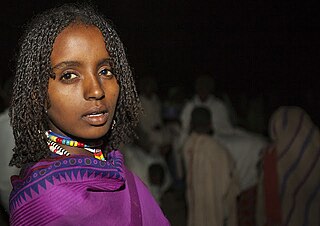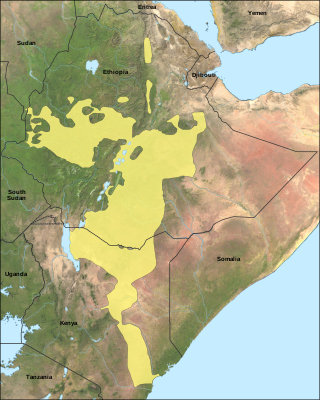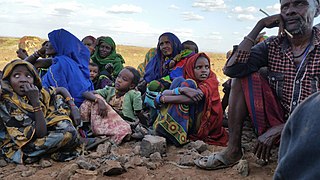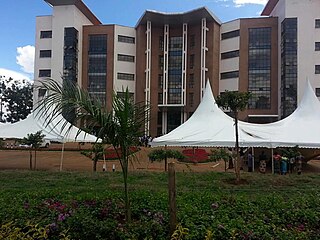Related Research Articles

The Oromo are a Cushitic ethnic group native to the Oromia region of Ethiopia and parts of Northern Kenya. They speak the Oromo language, which is part of the Cushitic branch of the Afroasiatic language family. They are one of the largest ethnic groups in Ethiopia. According to the last Ethiopian census of 2007, the Oromo numbered 25,488,344 people or 34.5% of the Ethiopian population. Recent estimates have the Oromo compromising 35.8% of the estimated 116,000,000 Ethiopian population placing Oromos at a population of 41,000,000

Oromo, historically also called Galla, is an Afroasiatic language that belongs to the Cushitic branch. It is native to the Ethiopian state of Oromia and Northern Kenya and is spoken predominantly by the Oromo people and neighboring ethnic groups in the Horn of Africa. It is used as a lingua franca particularly in the Oromia Region and northeastern Kenya.

Mijikenda are a group of nine related Bantu ethnic groups inhabiting the coast of Kenya, between the Sabaki and the Umba rivers, in an area stretching from the border with Tanzania in the south to the border near Somalia in the north. Archaeologist Chapuruka Kusimba contends that the Mijikenda formerly resided in coastal cities, but later settled in Kenya's hinterlands to avoid submission to dominant Portuguese forces that were then in control. Historically, these Mijikenda ethnic groups have been called the Nyika or Nika by outsiders. It is a derogatory term meaning "bush people."
The Yaaku are a people who are said to have lived in regions of southern Ethiopia and central Kenya, possibly through to the 18th century. The language they spoke is today called Yaakunte. The Yaaku assimilated a hunter-gathering population, whom they called Mukogodo, when they first settled in their place of origin and the Mukogodo adopted the Yaakunte language. However, the Yaaku were later assimilated by a food producing population and they lost their way of life. The Yaakunte language was kept alive for sometime by the Mukogodo who maintained their own hunter-gathering way of life, but they were later immersed in Maasai culture and adopted the Maa language and way of life. The Yaakunte language is today facing extinction but is undergoing a revival movement. In the present time, the terms Yaaku and Mukogodo, are used to refer to a population living in Mukogodo forest west of Mount Kenya.

The Meru or Amîîrú are a Bantu ethnic group that inhabit the Meru region of Kenya. The region is situated on the fertile lands of the north and eastern slopes of Mount Kenya in the former Eastern Province.

The Rendille are a Cushitic-speaking ethnic group inhabiting the northern Eastern Province of Kenya.
The Garre are a prominent Somali clan that traces its lineage back to Samaale, who is believed to have originated from the Arabian Peninsula through Aqiil Abu Talib. The Garre clan is considered to be a sub-clan of the Digil-Rahanweynl clan family, which is part of the larger Rahanweyn clan. However, genealogically, they are descended from Gardheere Samaale. The Garre are also categorized as southern Hawiye as well.
The Agumba people were an ethnic group who inhabited the forests of Mount Kenya, but are now either extinct or assimilated.
Meru is a Bantu language spoken by the Meru people (Ameru) who live on the Eastern and Northern slopes of Mount Kenya and on the Nyambene ranges. They settled in this area after centuries of migration from the north.

The Orma is one of the Oromo clans in the Horn of Africa who predominantly live in Tana River County in northern Kenya and in southern Ethiopia. They share a common language and cultural heritage with Oromo clans. First and foremost they are pastoralists and almost all are Muslims. In 2019 the Orma numbered 158,993.

Chuka is a town on the eastern slopes of Mount Kenya, in Kenya about 65 km south Of Meru Town. It falls within Tharaka-Nithi County and the former Eastern Province. Between 1992 and 2009, Chuka was the capital of Tharaka Nithi District. Tharaka Nithi District was further split into Meru South and Tharaka Districts with Chuka remaining the Capital of Meru South. Later, Meru South and Tharaka were amalgamated into Tharaka-Nithi County.
Shungwaya is an origin myth of the Mijikenda peoples. Traditions known collectively as the "Shungwaya myth" describe a series of migrations of Bantu peoples dating to the 12th-17th centuries from a region to the north of the Tana River. These Bantu migrants were held to have been speakers of Sabaki Bantu languages. Other Bantu ethnic groups, smaller in number, are also suggested to have been part of the migration. From Shungwaya, the Mount Kenya Bantu are then proposed to have broke away and migrated from there some time before the Oromo onslaught. Shungwaya appears to have been, in its heyday, a multi-ethnic settlement with extensive trade networks. Between perhaps the 12th and 15th centuries, this settlement was subjected to a full scale invasion of Cushitic speaking Oromo peoples from he Horn of Africa. From the whole corpus of these traditions, it has been argued that Shungwaya comprised a large, multi-ethnic community.
The Lumbwa were a pastoral community which inhabited southern Kenya and northern Tanzania. The term Lumbwa has variously referred to a Kalenjin-speaking community, portions of the Maa-speaking Loikop communities since the mid-19th century, and to the Kalenjin-speaking Kipsigis community for much of the late 19th to mid-20th centuries.
The Loikop people, also known as Wakuafi, Kor, Mu-Oko, Muoko/Ma-Uoko and Mwoko, were a tribal confederacy who inhabited present-day Kenya in the regions north and west of Mount Kenya and east and south of Lake Turkana. The area is roughly conterminous with Samburu and Laikipia Counties and portions of Baringo, Turkana and (possibly) Meru Counties. The group spoke a common tongue related to the Maasai language, and typically herded cattle. The Loikop occasionally interacted with the Cushitic, Bantu, and Chok peoples. The confederacy had dispersed by the 21st century.
Mbwaa is an origin narrative of the Meru peoples of Kenya. It is a widely told tale that has been narrated for at least three centuries. These traditions have been widely linked to the Shungwaya origin narrative. However it has been noted that a number of inconsistencies appear in the telling of this narrative. It thus may be, a conflation of two or more peoples origin narratives. Indeed subsequent events in the narrative lead up to the assimilation of two peoples, referred to as Muku-Ngaa and Murutu, both of whom contribute to the present Meru identity.
The Ngaa people were a community that according to the traditions of many Kenyan communities inhabited regions of the Swahili coast and the Kenyan hinterland at various times in history.
The Athi were an ethnic group who lived around Mount Kenya up to and during the eighteenth and possibly nineteenth centuries. Many of their traditions have been captured among the Meru and Kikuyu people of Kenya. According to Meru traditions, the Athi were predated in their areas of occupation by the Agumba people.
The Burkineji were a pastoral community who inhabited regions of northern Kenya through to the late 19th century. The present day Samburu consider themselves a descendant community of the Burkineji.
The Mukogodo, are a people who are said to have lived in regions of central Kenya around Mt. Kenya, possibly through to the 18th century. A community known as the Yaaku later moved into their territory and the Mukogodo, adopted the Yaaku language, referred to as Yaakunte. The Yaaku community was later assimilated by a food producing population and they lost their way of life. Their language, Yaakunte, was kept alive for some time by the Mukogodo who had all along maintained their own hunter-gathering way of life. However, the Mukogodo were later assimilated by the Maasai and adopted the Maa language. The Yaakunte language is today facing extinction but is undergoing a revival movement. In the present time, the terms Yaaku and Mukogodo, are used to refer to a population living in Mukogodo forest west of Mount Kenya.
Rauso was a region in the Horn of Africa in Late Antiquity.
References
- 1 2 3 Fadiman, J. (1994). When We Began There Were Witchmen. California: University of California Press. p. 53. ISBN 9780520086159.
- ↑ Fadiman, J. (1994). When We Began There Were Witchmen. California: University of California Press. p. 19. ISBN 9780520086159.
- 1 2 Fadiman, Jeffrey (1994). When We Began There Were Witchmen. California: University of California Press. pp. 81–83. ISBN 9780520086159.
- ↑ Fadiman, J. (1994). When We Began There Were Witchmen. California: University of California Press. pp. 63–64. ISBN 9780520086159.